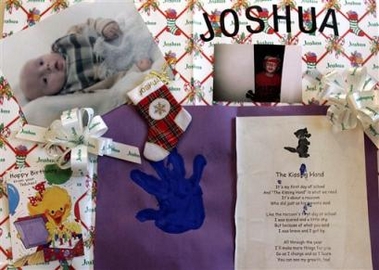|
Report: Plane needed more runway to land safely at Chicago airport
(AP)
Updated: 2005-12-16 11:17
A jetliner that skidded off a landing strip and into a city street needed
about 800 more feet (245 meters) of runway to come to a safe stop, federal
investigators said.
The Southwest Airlines jet crushed a car, killing a 6-year-old boy, after it
skidded off a 6,500-foot (1,980-meter) runway and crashed through a fence at
Midway International Airport earlier this month.
A preliminary investigation by the National Transportation Safety Board shows
the airplane touched down with about 4,500 feet (1,370 meters) of runway
remaining, but snowy conditions and other factors meant the plane ideally needed
about 5,300 feet (1,615 meters) of runway, according to a report released
Thursday.

A montage of photos and school memories made
by family members of Joshua Woods is displayed at his funeral, Wednesday,
Dec. 14, 2005, in Steger, Ill. Joshua, 6, was killed when a plane trying
to land in a snowstorm at Chicago's Midway Airport skidded off the runway,
striking the vehicle he was riding in with his family.
[AP] | Jim Hall, a former NTSB chairman not involved in the investigation, said the
pilots landed the plane too late.
"You can come to the conclusion that the plane landed long. It touched down
too far down the runway," he said Thursday.
The jet's actual stopping distance was about 5,000 feet (1,520 meters), the
NTSB report said. A tail wind contributed to the accident because it caused the
plane to land faster than normal, according to the report.
Southwest Airlines spokeswoman Beth Harbin declined comment on the NTSB's
findings.
Midway, which is surrounded by dense neighborhoods, lacks the Federal
Aviation Administration's recommended 1,000-foot (304-meter) buffer zone at the
end of its runways. Only 82 feet (25 meters) separated the end of the runway and
the fence the aircraft crashed through.
Chicago aviation officials have said the FAA has determined there is not
enough room at the end of Midway's airstrips to install beds of crushable
concrete that can slow an aircraft if it overshoots a runway.
Midway is among nearly 300 commercial airports in the U.S. that don't have
adequate runway buffers. A recently passed federal law requires the airfields to
extend runway barriers by 2015 or build the concrete beds.
City Department of Aviation officials did not immediately return a call for
comment Thursday about the NTSB report.
The report said the captain told investigators that the plane's thrust
reversers, which should have slowed the jetliner, didn't immediately kick in
when he tried to deploy them.
The first officer was able to deploy the thrusters several seconds later.
The captain also said that the plane didn't decelerate normally so he applied
the brakes manually. When the first officer noticed the problem, he moved his
seat forward to apply maximum braking, the report said.
Both crew members said they applied maximum pressure to the brakes as the
airplane skidded off the runway and came to a stop in the street.
Air traffic controllers said the runway's conditions were fair for most of
the runway and poor at the end, according to the NTSB.
Joshua Woods of Leroy, Indiana, who was killed in the accident, was buried
Wednesday. It was the first fatal crash in Southwest's 35-year history.
A law firm representing the boy's family said in a statement Thursday that
the NTSB findings were an "unequivocal statement" that the plane should not have
landed, and the crew was "not prepared for the landing."
Attorney Ronald Stearney Jr. has said the family plans to
sue.
|